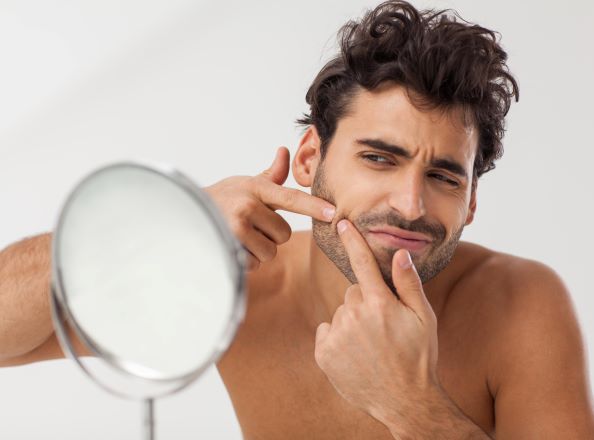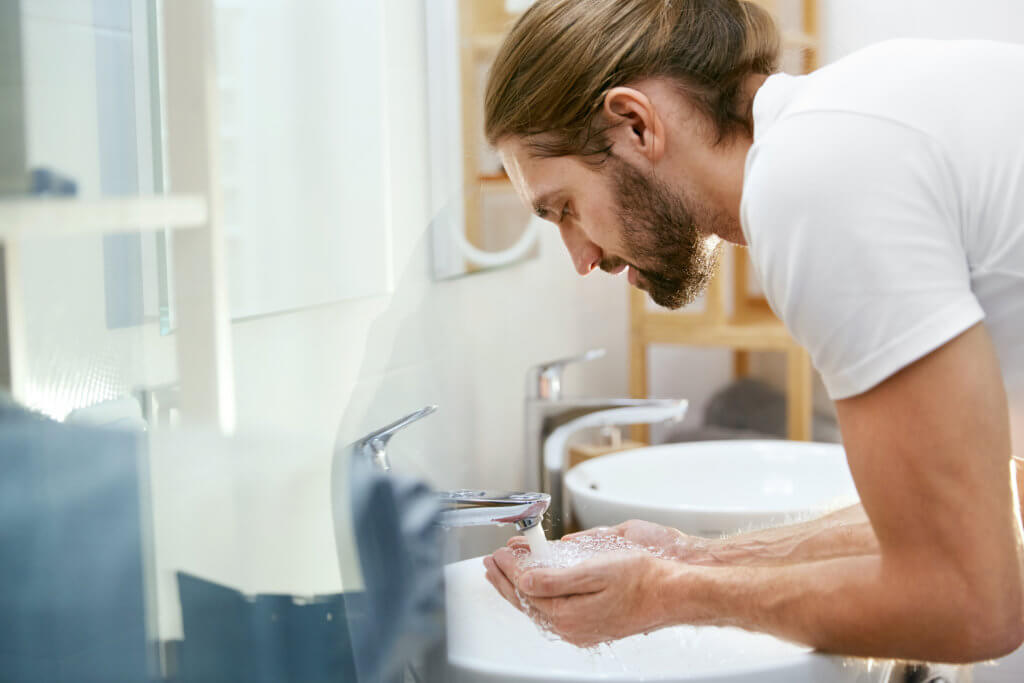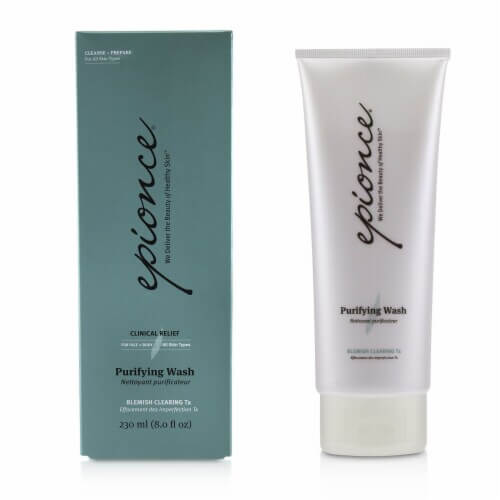Answering the question, “Do beards cause acne?” is actually more complicated than you might imagine. According to Dr. Sam Awan of U.S. Dermatology Partners in Plano and McKinney, Texas, “Simply growing a beard will not cause acne, but certain aspects of beard care and maintenance may make people with beards more likely to experience breakouts, especially if that person has acne-prone skin.” Keep reading to learn more from Dr. Awan about what beard acne is, the causes and risk factors, and most importantly, the skincare tips and recommendations for managing beard acne breakouts.
What Is Beard Acne?
According to Dr. Awan, “As the name suggests, beard acne occurs when acne blemishes develop in the pores or hair follicles in the beard. You may also hear people referring to beard acne as folliculitis or pseudofolliculitis. Technically, folliculitis is not acne, but many of the treatments and preventive measures for folliculitis and acne are the same. They also both frequently affect the skin below the beard, so it’s important to understand how to address beard acne and folliculitis.”
What Causes Beard Acne?
Acne is often associated with hormonal fluctuation, especially changes in hormones that occur during the teenage years. Beard acne is not typically caused by hormonal changes. Instead, beard acne develops either because of a bacterial infection in the pores (true folliculitis) or an inflammatory response around the hair follicles due to irritation (pseudofolliculitis). When the body’s natural oil (sebum) mixes with dead skin cells and beard care products, it can clog pores, trapping bacteria and leading to infection, irritation, and inflammation. Sebum oil can also prevent beard hairs from growing naturally from the follicles, leading to pimple-like bumps on the skin. Shaving close to the skin will often lead to inflammation around the hair follicle, leading to shaving bumps that can leave behind pink or dark pigmentation.
Can Beard Acne Be Prevented?
When it comes to preventing beard acne, Dr. Awan says, “The right skin and beard care routine can significantly reduce the risk of beard acne breakouts and folliculitis flare-ups. By taking steps to prevent beard acne before it begins, you can also reduce the severity and longevity of flare-ups in this skin condition.”
- Wash your beard – Like the hair on top of your head, beard hair needs to be washed regularly. Without regular washing, beard hair gets oily, which can trap dead skin cells or emerging hairs, leading to acne breakouts. Make sure to rinse your beard thoroughly after cleaning since the residue can irritate skin and clog pores and hair follicles.
- Exfoliate – Exfoliation helps to remove dead skin cells and increase cell turnover, which prevents clogging pores and trapping hair within the follicles. You don’t necessarily need to exfoliate every day, but you should exfoliate a few times a week and anytime you are shaving or trimming your beard. Many dermatologists recommend using a chemical exfoliant (lactic acid, glycolic acid) over harsh physical scrubs.
- Change your shaving routine – As mentioned above, exfoliating before you shave can help reduce the risk of clogged pores. Shaving after showering can also be beneficial since the warm water and steam open up pores, soften hair, and reduce the risk of ingrown hairs. Changing razor blades regularly can also help prevent irritation and snagging hairs. Shave with the direction of the hair, rather than against the grain. Letting the beard grow out longer often helps minimize pseudofolliculitis. Razors that produce closer shaves are more prone to causing follicle irritation. Stretching the skin to produce a closer shave also increases the chances of irritation. Often people will find electric razors to be less likely to cause pseudofolliculitis.
- Use acne treatment – Apply a topical acne treatment to your beard and the whole face to clear any current blemishes and prevent future breakouts. There are acne spot treatments made specifically to be applied to blemishes, but it can be beneficial to find a gentle, topical acne treatment that can be applied to all areas of the skin. Look for topicals containing salicylic acid or benzoyl peroxide, but keep in mind these ingredients may not be suitable for all skin types.
- Brush your beard – Brushing helps to spread products evenly through the hair. It also keeps beard hair detangled, which is essential to minimize the risk of ingrown hairs.
- Moisturize – Many people think that moisturizing will cause more oiliness and lead to clogged pores. However, this isn’t true. Without proper moisturizing, skin may produce more sebum oil, which will lead to increased oiliness. Choose a lightweight moisturizer. Gel moisturizers are often easier to apply to the beard. You can also use your brush to work with moisturizer evenly throughout. If you’re experiencing itching, dryness, or razor bumps, moisturizer will help with this as well.
- Don’t touch your face – Frequently touching your face can transfer bacteria, dirt, and grime from the hands onto your face, which can lead to clogged pores.
- Always use clean linens – Use clean towels and washcloths when washing your beard. You should also clean your sheets and pillowcases regularly to avoid transferring dirt and oils onto the skin.
Shop Men’s skincare online at DermSkincare.com »
How Is Beard Acne Treated?
In addition to taking steps to prevent beard acne, you may need to incorporate over-the-counter or prescription-strength topical treatments and other dermatologist-recommended services. According to Dr. Awan, “In most cases, we’ll start by recommending patients incorporate some topical treatments for acne into their daily routine. If the beard acne breakout is especially severe, we may also recommend in-office treatments to help clear up the breakout.”
Some dermatologic treatments that may be recommended for beard acne include:
- Medicated face wash – Find a medicated face wash with antibacterial and anti-inflammatory ingredients like benzoyl peroxide and salicylic acid. These face washes will help clear up the current breakout and prevent future breakouts. For the face, a lower strength (around 4%) benzoyl peroxide wash is sufficient.
- Topical treatments – Spot treatments for acne can be applied directly to blemishes to help clear up even the most stubborn acne spots. General acne treatments that are gel-based tend to be more easily applied to address acne that develops within the beard. They can also be applied to other areas where acne may develop to reduce the risk of a breakout.
- Medicated shampoos – Certain beard care products can contribute to clogged pores, so it may be beneficial to utilize a medicated shampoo. These shampoos typically contain salicylic acid to clear up acne and diminish inflammation. As a bonus, you can also use medicated shampoo on your head if you’re struggling with dandruff or other concerns.
- Oral medications – Antibiotics, isotretinoin (), and hormonal therapy pills may be prescribed to reduce the number and severity of beard acne breakouts and prevent future flare-ups.
- Dermatologic treatments – You may also benefit from in-office dermatologic treatments like laser therapy or chemical peels. These professional solutions help to clear blemishes and promote healthy skin cell turnover to prevent future breakouts. When pseudofolliculitis occurs just around the periphery of the beard, laser hair removal has been used with excellent results.
- Pigmentation/scarring treatments – Many men are bothered more by the pigmentation left behind than the pseudofolliculitis itself. While the best treatment is to focus on the underlying pseudofolliculitis using the tips above, a dermatologist can discuss treatments to even out irregular pigmentation left behind by the inflammation in your skin.
- Pimple extraction – If you have very large or deep blemishes, your dermatologist may perform an extraction. While it’s not recommended to pop pimples at home, a dermatologist has the necessary tools and experience to remove pimples to relieve discomfort and shorten healing time without risking infection and scarring or making inflammation worse.
Visit U.S. Dermatology Partners to Create a Beard Acne Treatment Plan
When you’re ready to create the ideal beard acne prevention and treatment plan, get in touch with a U.S. Dermatology Partners office near you. We make it easy to get started. Simply take a minute to complete our quick, online form. Once our team members receive your request, they’ll be in touch to finalize the details of your upcoming visit.
Find a location near me
or




